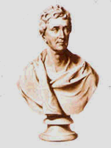




Acknowledgements
Destruction of Houses of Parliament: 1834, artist unknown. Considered to be in the public
domain – https://commons, wikimedia.org. Hansom Cab:
drawing, considered to be in the public domain –
https://commons.wikimedia.org. Soane:
marble bust by the English sculptor Francis Leggat Chantrey (1781-
1835 Andrew Jackson survives an assassination attempt, the first made
on an American president. A madman uses two pistols but both misfire.
A  across the St. Gotthard pass, linking southern Switzerland with
northern Italy, is completed in 1830. A
across the St. Gotthard pass, linking southern Switzerland with
northern Italy, is completed in 1830. A
railway tunnel is opened 50 years later.
1830 The
French tailor Barthélemy Thimonnier
invents one of the first  .
The following year, however, his competitors attack his factory
and destroy most of his machines.
.
The following year, however, his competitors attack his factory
and destroy most of his machines.
1834ZThe
hansom cab comes
into service in London. A two-
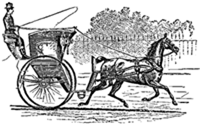
In 1832 the eminent German scientist Karl von
Reichenbach discovers the wood preservative
creosote. Other discoveries included paraffin.
1834 The Bavarian Franz Xaver Gabelsberger publishes a shorthand system for the German xxxxxxlanguage. The English version, devised by the Englishman Isaac Pitman, comes out in 1837.
In 1834 the Houses of Parliament, seat of the British government, are destroyed by fire. The London architect Charles Barry designs a new building, begun in 1840 and completed in 1867. His design in the Gothic style was chosen out of 97 entries submitted for the work.
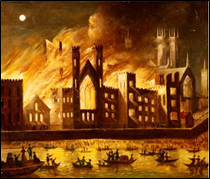
On his death in 1837 the English architect Sir John Soane bequeaths his house in Lincoln’s Inn Fields (now a museum) to the nation, together with his very valuable collection of antiquities and paintings, including works by Hogarth and Canaletto.
W4-
1830 Peter James Bossy becomes the last Englishman to
stand in the pillory. He suffers for one hour outside the Old Bailey.

In 1830 two Englishmen, Edwin Budding and John Ferrabee, manufacture the first ever lawn mower.

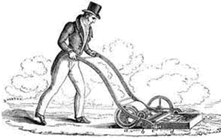
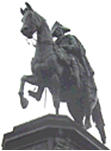

In 1830 the German sculptor Christian Daniel Rauch begins work on the statue of Frederick the Great in Berlin. It takes him twenty years to complete.
1833 In India a
successful campaign is waged against the “thugs”
(thag in Hindi), a gang of murderers
and thieves who had plagued the sub-

In 1833, the various insurance companies in London combine to form the London Fire Engine Establishment, made up of 80 firemen and 13 fire stations. This single force, one of the first of its kind, becomes the Metropolitan Fire Brigade in 1865 and the London Fire Brigade in 1904.

1836 sees the completion of the Arc de Triomphe in Paris, a monument to
xxxxxNapoleon’s victories in battle, and the largest triumphal arch in the world.


In 1835, the English locksmith Charles Chubb, famous for his unpickable locks, patents a burglar proof safe.



In 1835 the famous waxwork museum Madame Tussauds is established in
Baker Street, London. It moves to its present site in Marylebone Road in 1884.

1835 Henry Thomas De La Beche, a member
of the Geological Society in London, becomes
the director of the British Geological Survey, the
first survey of an entire country ever undertaken.
In his A Guide to Northern Antiquities of 1836 the Danish archaeologist Christian Thomsen is the first to come up with the divisions Stone, Bronze and Iron ages in the study of prehistory.
In 1837 the Estonian
naturalist Karl Ernst Von Baer (1792-



